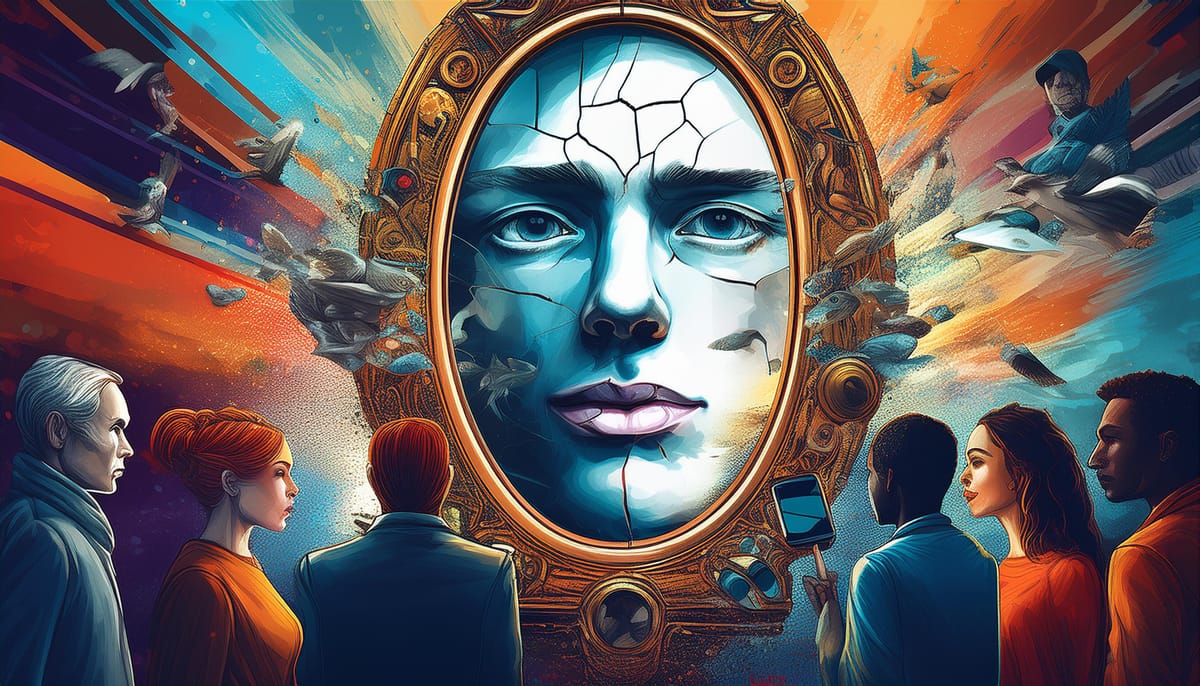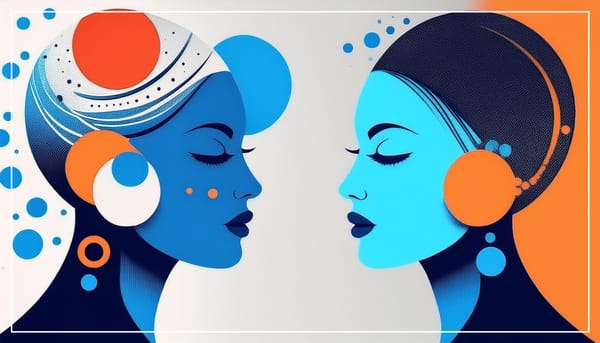Designing for All: Tech's Narcissus Trap

Welcome to the first installment of what I hope will be an ongoing larger discussion on inclusivity in product design and development. (Edit: part 2 is up!)
Mindful Product Development in Public Interest Technology
As I reflect on my journey in public interest technology, I'm struck by the incredible opportunity we have to create digital experiences that truly serve everyone. It's a passion that drives me to constantly think about how we can build accessible and inclusive technology that bridges the digital divide and empowers users from all walks of life.
During my time as Senior Director of Digital Product Management and Design at NYPL, I had the privilege of establishing a product development process that puts inclusivity and accessibility at its core. Through this experience, I've come to realize that the key to creating truly inclusive products isn't about reinventing the wheel, but thoughtfully integrating audience-focused practices into our existing development frameworks.
While my experience is rooted in public interest technology, the principles and practices of inclusive design are valuable across all tech sectors. By adopting these approaches, companies in various industries can expand their market reach, drive innovation, and create products that resonate with a broader, more diverse user base. This isn't just about social responsibility—it's a smart business strategy that can lead to increased user adoption, customer satisfaction, and ultimately, market share.
In this post, I want to explore a concept I call "The Narcissus Trap" - the tendency for tech professionals to design products that mirror their own experiences, often overlooking the broader user base. We'll examine the challenges of creating genuinely inclusive products and discuss strategies for expanding our perspectives as product managers and designers.
(Note that in the next post I have planned, I’ll start getting into more concrete strategies for breaking free from the Narcissus Trap and building truly inclusive products.)
The Trap
"The Narcissus Trap"is when tech professionals build products that reflect only themselves and their immediate experiences. Like Narcissus of Greek mythology, who became so enamored with his own reflection that he wasted away, we in tech risk creating products that serve only a narrow slice of humanity. Consider this reality about the current state of product management, design, and development:
- The overall demographic of dev teams is still mostly white, able-bodied men from Western, educated, industrialized, rich, and democratic backgrounds.
- In the US, only 7.4% of software developers are Black or African American, 22.3% are Asian, and women make up just 19% of software developers. [Reference]
- People with disabilities are massively underrepresented (though individuals with neurodivergence are thought to have more representation than those with physical disabilities) [Reference]
- The most popular software development processes we've been using are 25 years old. Like our software products, they were predominantly built by the same demographic.
- Humans have a hard time not building for themselves: It's tough to build products without imagining some version of yourself as the end user. We always self-identify, and having the ability to truly step outside of yourself is really hard.
This combination of factors – human nature, industry demographics, and outdated frameworks – makes it nearly impossible to seamlessly integrate an equity mindset into the product development lifecycle without intentional effort.
This isn't about pointing fingers or assigning blame. We're all susceptible to this trap, myself included. It's a natural human tendency to design for what we know.
The Danger of Assumed Neutrality: Breaking the Mirror
There's an implied assumption that our existing frameworks are neutral. The idea is that they're broad enough to account for all features and requirements irrespective of user group or business ethos. But in reality, there are no integrated checkpoints to help maintain a steady focus on diverse user needs, nor are there explicit mechanisms to ensure teams aren't introducing unintended consequences into their feature sets.
This assumed neutrality is a dangerous fallacy. It presupposes that by not explicitly addressing diversity and inclusion, these frameworks are somehow universally applicable. In reality, this "neutral" stance often defaults to the perspective of the dominant group, inadvertently perpetuating existing biases and exclusions.
The Challenge of Constant Bias Checks
Instead, there is a lot of advice for Product Designers and Developers to “examine the ego” as it relates to product development. Other suggestions you will come across include “ask yourself how you can be a better ally” or “consider the unintended consequences of the product or service you are building.” But how and when?
The best and most real answer is to bring diverse voices to the table. But even with more diverse teams we still have our own systemic and internalized bias that can get in the way. Most approaches rely on a vague and on-going self-awareness that people are not very good at.
Empathy is a learned skill. While these approaches are a step in the right direction, they fall short in several ways:
- Superficial Self-Reflection: The call to "check your bias" often results in superficial self-reflection rather than deep, transformative understanding.
- Lack of Structured Guidance: Without concrete tools or processes for identifying and addressing biases, teams are left to their own devices, which can lead to inconsistent results.
- Overemphasis on Individual Responsibility: By focusing on individual egos, these frameworks neglect the systemic and cultural biases that permeate organizations and industries.
- Insufficient Focus on User Diversity: The emphasis on personal bias doesn't necessarily translate into a comprehensive understanding of diverse user needs.
There are very few people I know who can maintain the constant check necessary to ensure bias is not injected into product development. This highlights a critical challenge in inclusive product development:
- Cognitive Load: Constantly checking for bias and maintaining an inclusive perspective is mentally taxing, especially when juggling other project demands.
- Skill Gap: As mentioned, empathy is a learned skill. Many professionals haven't received adequate training in inclusive design practices.
- Time Pressure: The fast-paced nature of product development often leads to shortcuts, and unfortunately, inclusivity considerations are often the first to be sacrificed.
- Competing Priorities: Balancing business objectives with inclusive design can create tension, especially when inclusivity is seen as a "nice-to-have" rather than a core requirement.
Self-awareness, like empathy, is a learned skill, especially in our professional environments. Without mechanisms to keep it proactive, constant and radical self-awareness is nearly impossible in the day-to-day of product development.
Given these challenges, it's clear that we need a more systematic approach to inclusive design—one that doesn't rely solely on individual awareness but is woven into the fabric of our development processes.
Reframing the Mirror
The key to overcoming the Narcissus Trap isn't shattering our existing processes, but refocusing and expanding them. We need to transform our self-reflective mirror into a wider lens that captures the diversity of our global user base. (I love a metaphor I can run with!)
Instead of creating entirely new frameworks, let's strategically integrate inclusive practices into our current ones. This means creating opportunities for product, design, and engineering teams to incorporate global perspectives into their daily work. By weaving inclusivity into the fabric of our existing software development frameworks, we ensure it becomes a natural part of every stage, rather than an afterthought.
While Product Design teams have made progress in this area, incorporating accessibility standards and broadening usability testing, these practices must extend beyond design teams and permeate the entire development process. This approach is particularly crucial in public interest technology, where serving diverse populations is at the core of the mission.
Beyond The Public Interest
Public interest technology is meant to serve and benefit the broader public, therefore the need for inclusive design is even more critical in this sector. But, we see this problem occurring in every industry. Here is a small sliver of how the Narcissus Trap manifests in the real world:
Social Media: The Narcissus Trap in social media often manifests in the design of content moderation algorithms. These algorithms, typically developed by teams from similar backgrounds, may fail to recognize hate speech or offensive content targeted at minority groups that the developers themselves don't experience. For instance, Facebook faced criticism for inadequately addressing hate speech in languages other than English, particularly in developing countries.
Enterprise Software: In enterprise software, the Narcissus Trap can lead to the creation of tools that assume a Western corporate work culture. For example, project management software might be designed with rigid hierarchical structures that don't accommodate more collaborative or flat organizational styles common in other cultures or industries. This can make the software less effective or even unusable for companies with different work cultures.
Mobile Apps: Dating apps provide a clear example of the Narcissus Trap. Many popular dating apps were initially designed with heterosexual, cisgender users in mind, failing to adequately serve LGBTQ+ communities. It took years for some apps to introduce options for non-binary gender identities or same-sex preferences, demonstrating how the developers' perspectives limited the initial user base.
AI and Machine Learning: The Narcissus Trap in AI can lead to biased algorithms. For instance, facial recognition software has been found to have higher error rates for women and people of color, likely due to training data that overrepresented white male faces. This bias can have serious consequences when such technology is used in law enforcement or security applications.
Wearable Technology: Early versions of fitness trackers often failed to accurately measure heart rates for people with darker skin tones, as the light-based technology was primarily tested on lighter skin. This oversight excluded a significant portion of potential users and provided inaccurate health data to others.
Voice Recognition Software: Many voice assistants and transcription services have struggled with accents and dialects different from standard American or British English. This limitation can make these technologies less accessible to non-native English speakers or those with regional accents, reflecting the narrow linguistic background of their developers.
These examples across various tech sectors illustrate how the Narcissus Trap can manifest in different ways, leading to products that fail to serve diverse user bases effectively. They underscore the importance of breaking free from our own limited perspectives to create truly inclusive technology.
Conclusion: Beyond the Mirror
Breaking free from the Narcissus Trap requires conscious effort and systemic change across all areas of technology development. By integrating inclusive practices into our existing frameworks and prioritizing diversity at every stage of product development, we can create technology that truly serves all users.
This approach isn't just about altruism—it's about creating better, more innovative technology that serves a broader market. It's about recognizing that our own experiences, while valuable, are limited, and that true innovation comes from understanding and designing for a diverse range of user needs and perspectives.
The challenges are significant, from the homogeneity in tech teams to the cognitive load of constant bias checks. However, the potential rewards—both in terms of social impact and business success—make this effort not just worthwhile, but essential in our increasingly diverse and interconnected world.
In the next post, we'll explore concrete strategies for breaking free from the Narcissus Trap and building truly inclusive products. We'll discuss how to integrate inclusive practices into existing frameworks, opportunities for mindfulness in the product development process, and the business case for inclusive design in both public and private sectors. By doing so, we can transform the way we approach technology development, creating products that reflect and serve the rich diversity of our global user base.
[Read Part 2: My Narcissus Trap Moment: Breaking the Mirror]
[Article image prompt: A surreal digital illustration of a diverse group of people looking into a large, ornate mirror shattering. The mirror's reflection should show a single young white man's face looking back at the group. Around the mirror, include various tech devices and symbols representing different cultures and abilities. Use a color palette that transitions from muted tones near the mirror to vibrant, diverse colors at the edges of the image. Style: Digital art with a touch of surrealism.]



